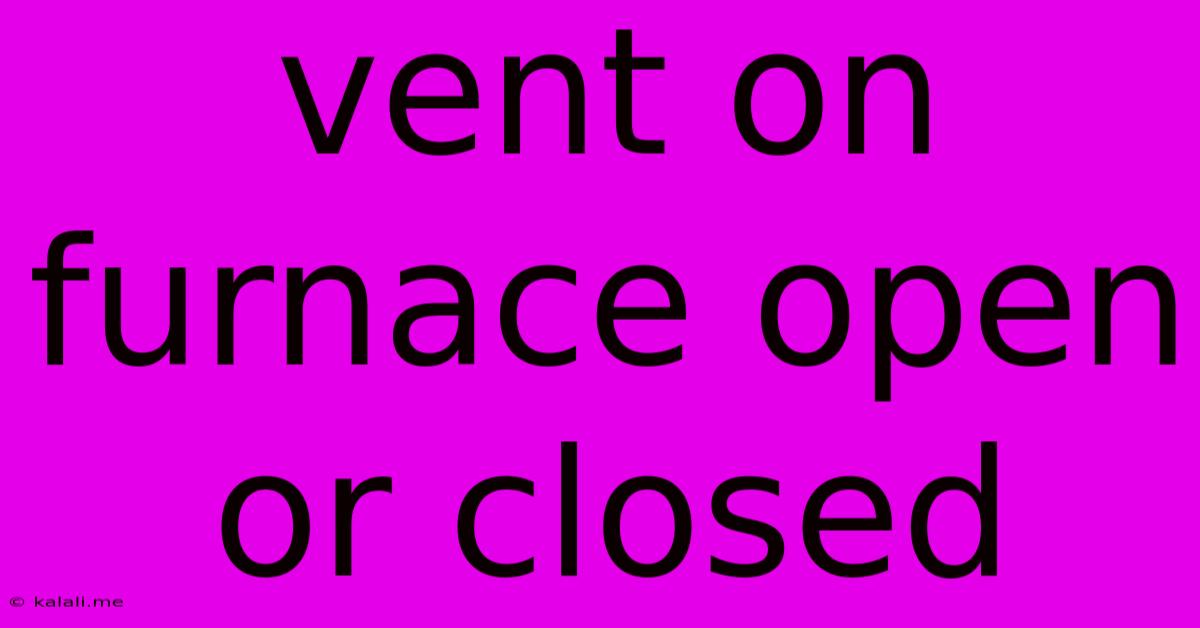Vent On Furnace Open Or Closed
Kalali
Jun 01, 2025 · 3 min read

Table of Contents
Vent on Furnace: Open or Closed? A Comprehensive Guide
Should your furnace vent be open or closed? This seemingly simple question can actually impact your home's safety, comfort, and energy efficiency. Understanding the role of the vent and when it should be open or closed is crucial for proper furnace operation. This guide clarifies the intricacies of furnace ventilation and helps you make informed decisions.
The furnace vent, also known as the combustion air intake or exhaust vent, is a critical component of your heating system. It allows for the intake of fresh air needed for combustion and the safe expulsion of exhaust gases. A malfunctioning vent can lead to carbon monoxide leaks, inefficient heating, and even fire hazards.
Understanding Furnace Ventilation: The Basics
Modern furnaces operate based on combustion. This process requires oxygen (from the intake vent) to burn fuel (natural gas or propane), producing heat and exhaust gases (removed through the exhaust vent). These two vents are crucial for maintaining a safe and efficient combustion process. Improperly managing these vents can have serious consequences.
There are two main types of furnace ventilation systems:
- Direct Vent Furnaces: These systems draw combustion air from the outside and vent exhaust gases directly outside, eliminating the need for an intake vent inside the home. They are generally safer and more energy-efficient.
- Indirect Vent Furnaces: These systems draw combustion air from inside your home and vent exhaust gases outside. They require proper ventilation within the home to prevent the depletion of oxygen and the buildup of combustion byproducts.
Should My Furnace Vent Be Open or Closed?
The answer to this question is largely determined by your furnace type:
-
Direct Vent Furnaces: These furnaces do not have an interior vent that needs to be opened or closed. All air intake and exhaust are handled externally through dedicated pipes. Any tampering with external venting should be left to qualified HVAC technicians.
-
Indirect Vent Furnaces: These furnaces typically do not have a manually operated vent that you open or close. The air intake and exhaust are passively managed through strategically placed vents and openings in your home. Closing or blocking these openings can lead to dangerous carbon monoxide buildup. However, some older systems might have manually adjustable dampers, but attempting to adjust these yourself is strongly discouraged.
Identifying Your Furnace Type
Determining whether you have a direct or indirect vent furnace is essential. Check your furnace's manual or look for identifying markings on the unit itself. The manual will clearly indicate the ventilation type.
Maintaining Proper Ventilation: Crucial Safety Measures
Regardless of your furnace type, maintaining proper ventilation is crucial for safety and efficiency:
- Regular Inspections: Schedule annual inspections by a qualified HVAC technician. They can check for blockages, leaks, and other potential problems with your ventilation system.
- Clear Airflow: Ensure that vents and registers throughout your home are unobstructed. Furniture, drapes, and other items can restrict airflow, impacting the furnace's performance and potentially leading to carbon monoxide buildup.
- Carbon Monoxide Detectors: Install and maintain working carbon monoxide detectors on every level of your home. This is a critical safety precaution, regardless of your furnace type.
- Never Tamper with Vents: Unless you are a qualified HVAC professional, do not attempt to adjust or modify your furnace's ventilation system.
In conclusion, understanding your furnace's ventilation system is key to ensuring its safe and efficient operation. Leave any adjustments or repairs to certified professionals. Prioritizing regular maintenance and carbon monoxide detection safeguards your home and family. If you have any doubts about your furnace's ventilation, contact a qualified HVAC technician for assistance.
Latest Posts
Latest Posts
-
Integral From Negative Infinity To Infinity
Jun 03, 2025
-
Does Date Home Was Built Matter
Jun 03, 2025
-
Can You Put Brackets Inside Brackets
Jun 03, 2025
-
In The Or At The Office
Jun 03, 2025
-
The 24 V Is Dc Power Overcurrent
Jun 03, 2025
Related Post
Thank you for visiting our website which covers about Vent On Furnace Open Or Closed . We hope the information provided has been useful to you. Feel free to contact us if you have any questions or need further assistance. See you next time and don't miss to bookmark.